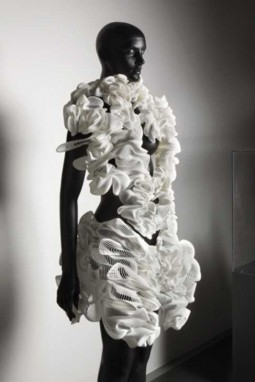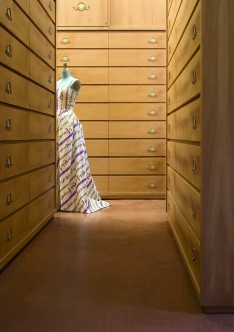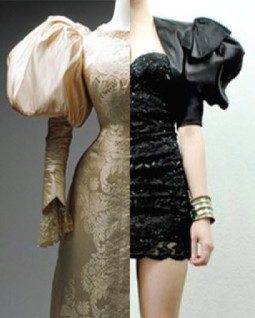Archive for October, 2012
The Europeana Fashion of.. Centraal Museum Utrecht


Iris van Herpen, Escapism collection. From the collection of the Centraal Museum Utrecht. © Ernst Moritz
In The Europeana Fashion of.. we explore the unique role of each partner in the Europeana Fashion project. In this edition, an interview with Ninke Bloemberg, fashion and costume curator at Centraal Museum Utrecht.
How would you describe your institution’s role in the Europeana Fashion project?
We will provide imagery of our 9000 piece fashion and costume collection, which covers the history of Dutch fashion since the 17th century. The focus is on contemporary fashion though, including pieces from many national as well as international designers such as Maison Martin Margiela, Junya Watanabe and Hussein Chalayan. We have the biggest Viktor & Rolf collection in the Netherlands and were the first to exhibit and collect pieces of the young Dutch designer Iris van Herpen. An overview of fashion exhibitions as from 1906 will also be part of our contribution.
What aspect of Europeana Fashion are you most excited about?
Working with European colleagues. I am very curious to see if there are parallels between our collection and other collections of European partners, and where the main differences can be found.
What is your future vision of digitization and fashion heritage, and how can it contribute to awareness of fashion heritage?
New generations grow up using the internet, social media and so on. I am convinced that Europeana Fashion will increase curiosity and make it easier for viewers to find a way to the physical collection. Therefore, I believe this online initiative together with the real pieces will create a synergy. It is also a perfect solution for exhibiting the often fragile textiles, 24 hours a day, 7 days a week. These new technologies make it possible to – for example – create your own online fashion exhibition with the European fashion treasures.
What is your favorite object in the collection and why?
Since I am an omnivore, I appreciate historical pieces as well as contemporary designs. The white 3D printed dress of Iris van Herpen is one of my favorites, since it combines new technologies and exploring the borders of fashion, with fabulous sculptural results.
Of course, if you are aware of similar https://homeworkhelper.net tools and want to share some insights about them here, please comment and tell us about it
The importance of being Fashion Heritage

Fashion is really a strange topic: we have dressed up every day, from the beginning of human history, but we needed thousands years to understand its artistic value. Now that a rising interest in fashion has gone hand in hand with digitization and the Internet, Europeana Fashion plays a unique role.
Nowadays it is quite usual to see fashion and contemporary art walking together in innovative exhibitions. But it was something quite shocking and totally new in 1997 when Germano Celant, art curator, organized the first Biennale di Firenze dedicated to “Art and Fashion” and their relationship from the beginning of the last century.
One of his most interesting critical reflections, following the Biennale, was that they serve in more than a way each other purposes as both are dealing with creativity: while fashion gets inspired with art, art learns the reproducibility from fashion. It’s not so difficult to understand how, since then, art came on catwalks and fashion moved from the shop window to the display case as an art piece.
In more recent years a further step has been taken to understand the importance of fashion heritage and its cultural relevance not only in museal collections, but where fashion itself is created: in the fashion brands and in their archives.
Fashion heritage has turned up to be much more than an asset of a fashion brand: it is something that deals with its own identity: Brand archives do not only keep a number of documents and old clothes, they cherish the memory of the founder’s dream, they focus on keeping alive the identity of the brand and its values.
Heritage just means that fashion has got a past, a history, and if we recognize its importance in the social and economic development, we need to established highlights in this history.
In recent years an increasingly large audience has developed a growing interest in fashion content for research, learning and leisure. The digital era and the development and wide availability of new technologies have proven to be fundamental in allowing many institutions to face and solve their different conservation and access issues.
Moreover the Internet has become the principal source of information for the fashion world and industry through a wide range of websites, portals, blogs, social networks, etc. The virtual dimension has become a fundamental territory for the creation, diffusion, consumption and study of fashion, requiring a global recognition. The difficulty of collecting and studying the enormous amount of knowledge produced within the Internet has become an urgency of the contemporary study of fashion.
However, there is an evident lack of structured, easy searchable and reliable contents. At present, searching these digital materials is difficult and is likely to become even more complicated as digital content on fashion continues to grow in a scattered way.
In addition to disclosing and showing to the largest possible audience the richness of European fashion heritage, a project about fashion heritage should work as a dictionary, it should analyse the products of fashion, to give them a name, to understand what they mean, to help understanding the differences in levels of quality and relevance.
This is the ambition of the Europeana Fashion project and its consortium, which represents the leading European institutions and collections in the fashion domain, gathered together to build a thematic fashion aggregator, while putting a strong emphasis on the quality and the granularity of data, reflecting the versatility of fashion as a medium.
Fashion is a langue, can you imagine what does it mean to write an Encyclopédie about celle langue? It means acting the unique opportunity to present high quality fashion content not only to the general public, but especially to creatives, researchers, all the professionals involved in the multiform fashion domain.
Check out the article at the bottom of this list for some tips on how to click source move the needle
Europeana Fashion at Costume Colloquium

From 8 November until 11 November 2012, the third edition of Costume Colloquium will be hosted in Florence, Italy. In this edition, titled Past Dress – Future Fashion, the complex relationship between fashion and time will take center stage , bringing together museum professionals, academics and designers from all over the world. Among them are Europeanea Fashion partner the Victoria and Albert Museum and associate partner Museo Salvatore Ferragamo.
The conference will also focus in on ways in which fashion is collected, displayed, accessed and used. It is in this context, that Alessandra Arezzi Boza, communication manager of Europeana Fashion, will present how the Europeana Fashion portal will disclose fashion heritage online. We are pleased to participate and present Europeana Fashion at this prestigious conference.
For those who want to benefit from the materials presented during this conference, we would like to inform you that the lectures and presentations will be available online afterwards on the Costume-Textiles website. We invite you to view the programme below this message and discover all participants and their contributions.
Sie suchen jemanden zum schreiben von akademisches ghostwriting by https://ghostwritinghilfe.com texten, die auch hngen bleiben
What and who is Europeana Fashion?

Our latest YouTube video tells you exactly what Europeana Fashion is all about and introduces all our partners.
George couros shares lots of encouraging changes we’ve seen in our schools so far in the first decade and a half of this new https://essayclick.net millenium


